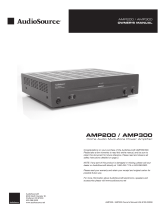
IIIIIIIJ\UDIO
Impedance Matching
LENIS
INSTALLATION GUIDE
SMOOTH
FACIA
VOLUME CONTROL
1 . Find out the minimum impedance of the amplifier. This
information may be found
in
the manual or on the back
of
amplifier, near the speaker terminals.
It
is
measured
in
ohms. .
...
....
NOTE:
To
prevent from
overloading and damaging
the amplifier, the switch must
be set correctly to match the
impedance of the speaker
system to a
level
equal to or
greater than the impedance
of
the amplifier.
. . . . . . . .
2.
Figure out the total number of speaker pairs to be used.
3.
Determine the correct switch setting using the chart below.
4.
Set the switch. Make sure that each volume control's
switch setting
is
consistent throughout the whole system.
No.
of
8
ohm
pairs
1 2 3 4 5 6 7 8
SLS Model
~
~
~
SLK Model
0
0
RECEIVER/AMPLIFIER ••
·M
.,
.,
SPEAKER
OUTPUTS
Limited Warranty ·
D
□
□
1.
2.
3.
4.
Switch
Settings
1/2x 1/2x
4x 4x
Bx Bx
Bx Bx
Installation Instructions
Route the cable into the volume control J-box
in
a way that allows for
easy access to the connectors on the SVC
Make sure to use the integral strain reliefs where appropriate when
routing the cable
in
the J-box.
Mark the input and output cables accordingly for easy installation.
Strip the insulation off the end of each of the eight individual wires
( four from the amplifier and four
to
the speakers) at about 1 /4". Twist
exposed ends together.
5.
Connect the leads from amplifier to the volume control connector
according to the labeled Input L [ + , - ] and R [ + , -
].
6. Connect the speakers wires to the connector labeled Output
L [ + , - ) and R [ + , -
).
Speaker wires typically use the
following color configuration.
-Red/Black = right speaker
Red
= positive [ + ] Black = ground [ - ]
-White/Green = left speaker White = positive [ + ]
Green
= ground [ - ]
7.
Insert the volume control into the J-box. Mount carefully, making sure
that no wires
are
pinched or shorted. Mount the cover baseplate to
the volume control then snap on the smooth facia cover.
OSD Audio will repair or replace any defect it
in
material or workmanship which occurs during normal use
of
this product with new
or
rebuilt parts free
of
charge
in
the US for five
years from date
of
original purchase. This warranty does not cover damages
in
shipment, failure caused by other products not supplied by OSD Audio or failures due to accident,
misuse, or alteration
of
the equipment. This warranty is extended only to the original purchaser and a purchase receipt, invoice
or
other proof of original date will be required before
warranty repairs are provided
Mail
in
service
can be obtained during period by emailing [email protected]. A return authorization number must be obtained iri advance and be marked on the outside of
the shipping carton.
This warranty gives you specific legal rights and may have other rights (which vary from state to state). If a problem with this product develops during or after the warranty period
please contact OSD Audio or your dealer.
OSD Audio I Brea, CA I osdaudio.com












